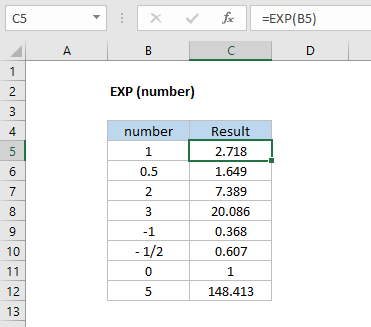Excel EXP Function
The Excel EXP function returns e raised to the power of specified number, i.e., ex. Here, e is the base of the natural system of logarithms, and its value is approximately 2.718282. The EXP function is the inverse of the LN function.
The EXP function is a built-in function in Excel that is categorized as a Math/Trig Function. It can be used as a worksheet function and a VBA function in Excel. As a worksheet function, the EXP function can be used as part of a formula in a worksheet cell. While as a VBA function, this function can be used in a Excel macro code. The Excel macro code can be created using the Microsoft Visual Basic Editor.
Syntax
EXP(number)
Parameters
number |
Required. Specify the power to which that e is raised to. |
Return Value
Returns e raised to the power of specified number.
Notes
- If the argument is a non-numeric value, EXP returns #VALUE! error.
Example: Using as Worksheet Function
The example below shows how to use the EXP function as worksheet function.

Based on the Excel spreadsheet above, the output of the following worksheet formula will be:
=EXP(B5) Result: 2.718281828 =EXP(B6) Result: 1.648721271 =EXP(B7) Result: 7.389056099 =EXP(B8) Result: 20.08553692 =EXP(B9) Result: 0.367879441 =EXP(B10) Result: 0.60653066 =EXP(B11) Result: 1 =EXP(B12) Result: 148.4131591
Example: Using as VBA Function
The EXP function can also be used in VBA code in Microsoft Excel. Consider the example below:
Dim FValue As Double FValue = Exp(2)
In this example, the variable called FValue will contain the value of 7.38905609893065.
❮ Excel Functions


